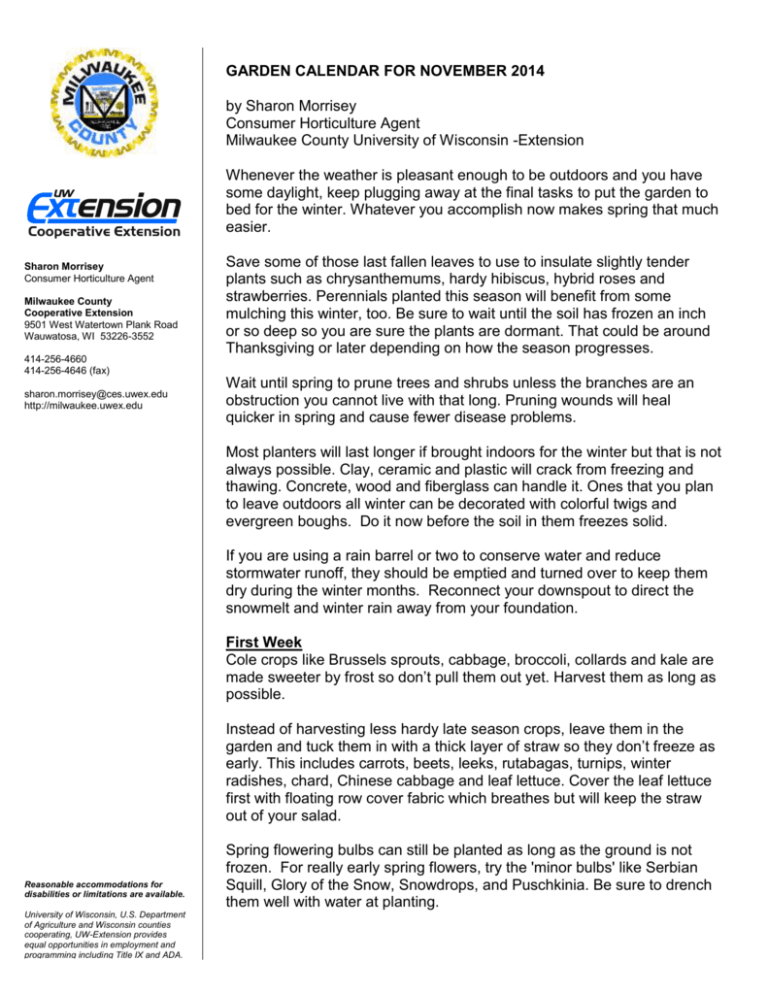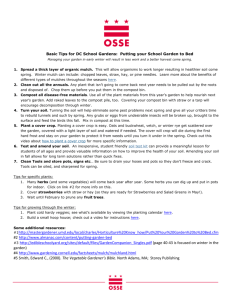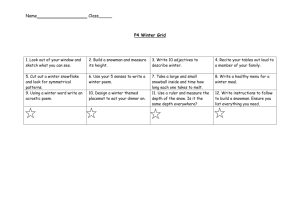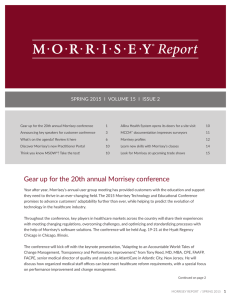GARDEN CALENDAR FOR NOVEMBER 2014 by Sharon Morrisey
advertisement

GARDEN CALENDAR FOR NOVEMBER 2014 by Sharon Morrisey Consumer Horticulture Agent Milwaukee County University of Wisconsin -Extension Whenever the weather is pleasant enough to be outdoors and you have some daylight, keep plugging away at the final tasks to put the garden to bed for the winter. Whatever you accomplish now makes spring that much easier. Sharon Morrisey Consumer Horticulture Agent Milwaukee County Cooperative Extension 9501 West Watertown Plank Road Wauwatosa, WI 53226-3552 414-256-4660 414-256-4646 (fax) sharon.morrisey@ces.uwex.edu http://milwaukee.uwex.edu Save some of those last fallen leaves to use to insulate slightly tender plants such as chrysanthemums, hardy hibiscus, hybrid roses and strawberries. Perennials planted this season will benefit from some mulching this winter, too. Be sure to wait until the soil has frozen an inch or so deep so you are sure the plants are dormant. That could be around Thanksgiving or later depending on how the season progresses. Wait until spring to prune trees and shrubs unless the branches are an obstruction you cannot live with that long. Pruning wounds will heal quicker in spring and cause fewer disease problems. Most planters will last longer if brought indoors for the winter but that is not always possible. Clay, ceramic and plastic will crack from freezing and thawing. Concrete, wood and fiberglass can handle it. Ones that you plan to leave outdoors all winter can be decorated with colorful twigs and evergreen boughs. Do it now before the soil in them freezes solid. If you are using a rain barrel or two to conserve water and reduce stormwater runoff, they should be emptied and turned over to keep them dry during the winter months. Reconnect your downspout to direct the snowmelt and winter rain away from your foundation. First Week Cole crops like Brussels sprouts, cabbage, broccoli, collards and kale are made sweeter by frost so don’t pull them out yet. Harvest them as long as possible. Instead of harvesting less hardy late season crops, leave them in the garden and tuck them in with a thick layer of straw so they don’t freeze as early. This includes carrots, beets, leeks, rutabagas, turnips, winter radishes, chard, Chinese cabbage and leaf lettuce. Cover the leaf lettuce first with floating row cover fabric which breathes but will keep the straw out of your salad. Reasonable accommodations for disabilities or limitations are available. University of Wisconsin, U.S. Department of Agriculture and Wisconsin counties cooperating, UW-Extension provides equal opportunities in employment and programming including Title IX and ADA. Spring flowering bulbs can still be planted as long as the ground is not frozen. For really early spring flowers, try the 'minor bulbs' like Serbian Squill, Glory of the Snow, Snowdrops, and Puschkinia. Be sure to drench them well with water at planting. Check houseplants for insects that may have come indoors as you brought the plants inside. Pick pests off by hand or use insecticidal soap or ultrafine oil to control. Give foliage a sponge bath or shower regularly to keep leaf pores clear. Outdoor planters, hanging baskets, and window boxes should be emptied and washed thoroughly with soap and a mild bleach solution before storing for next year. Second Week Lawns left too tall over the winter encourage disease problems like snow mold and tunneling of meadow mice. Once the leaves are all off the trees, mow one final time at 2 - 2 1/2 inches. Mark or make a mental note of lawn areas infested with crabgrass this year so you can spot treat with a pre-emergent herbicide next spring. Crabgrass is easy to see now since it turns purple and then brown when killed by frost. Prune everbearing raspberries if you did not do so after this fall's harvest. If you cut or mow all canes to the ground now there will be no spring harvest but a larger fall harvest next year. It also reduces insect and disease problems. Water all needle and broadleaf evergreens one last time before the ground freezes since winter wind and sun will continue to demand water from these plants through their leaves all winter. Excess water loss can lead to "winter burn" or death. Amaryllis bulbs that have rested for at least 10 weeks can be repotted, watered and brought into a bright room to produce flowers for the holidays. Keep checking tomatoes and other produce in storage discarding the rotting fruits and using those that have colored up. Third Week Wrap the trunks of young and tender trees to prevent sunscald. Paper tree wrap can prevent the rapid temperature changes in the bark that cause frost cracking and sunscald. They do not provide protection from the chewing of mice, voles, rabbits and other pests. For this use plastic or wire applied at least 1 - 2 feet higher up the trunk than the expected snow level. Clear away weeds, tall grass and leaves from the trunk area to reduce nesting sites for these pests, too. Move pesticides and plastic equipment to someplace where they will not freeze. Always store pesticides in locked cabinets or up out of reach of children. Keep them in their original containers. Cover labels with clear plastic tape to keep them clean and legible. File supplemental label information where it can be easily found and referred to before application next season. Stop fertilizing indoor plants now since they will use less water and nutrients until next spring due to the lower light levels. Keep flowering Thanksgiving cactuses well watered and out of drafts. Avoid moving them while in flower since this may cause them to drop flower buds. Cut down and discard asparagus stems and leaves that have yellowed completely. Removing these from the garden reduces disease and insect problems next year. Take soil samples for testing by the UW Soils Lab or other State approved lab. Separate samples should be taken from areas that are used for different purposes or have different light and moisture conditions. Combine several individual samples from a single area to make a composite sample. More information can be found at http://uwlab.soils.wisc.edu . Fourth Week If the soil has frozen at least an inch deep, you can now apply protective mulch to woody plants or herbaceous perennials that are growing in above ground planters. You can first surround the planters with chicken wire or hardware cloth leaving enough room for at least 6 inches of tightly packed straw right up against the container. Cover the top with twice as much straw held in place with plastic or boards. Tender hybrid roses can be mounded with soil and then caged in chicken wire now even if the soil is not frozen. After the soil has frozen, stuff the cages with those dry leaves you saved. Rose canes do not need to be cut back until next spring but should be tied together to prevent whipping and rubbing against the wire. Now it’s time to cover even the cole crops such as broccoli, Brussels sprouts, kale, cabbage, turnips to prevent them from freezing solid. This is a good time to clean, sharpen, and oil garden tools and equipment. Oil and store gas powered equipment like lawn mowers and leaf blowers. Repair shops are in a slow period (at least until the snow flies and snowblowers need repair) so arrange for a tune-up and blade sharpening now.






